
|
Optimus Prime
Convoy
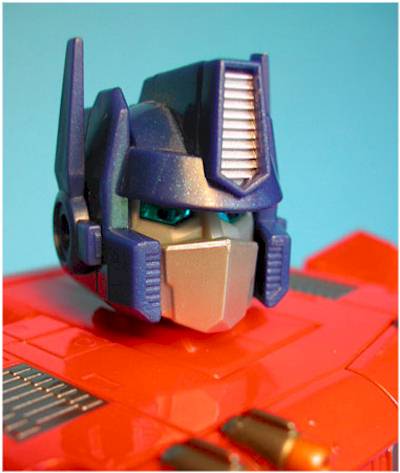
|

|
Poe Ghostal is back with a terrific review of the Optimus Prime Convoy.
Take it away, Poe!
In the past, I've argued that reviewing toys is an essentially frivolous venture, and that in my reviews I strove to entertain more than aid consumers in making purchasing decisions. This screed, which was critical of this very website (and for which I have apologized to Mr. Crawford), was laced with complex anti-consumerist sentiments that, I admit, I still feel somewhat today.
|
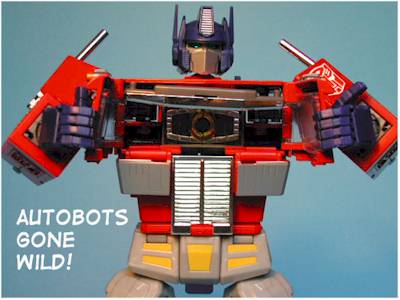
|
|
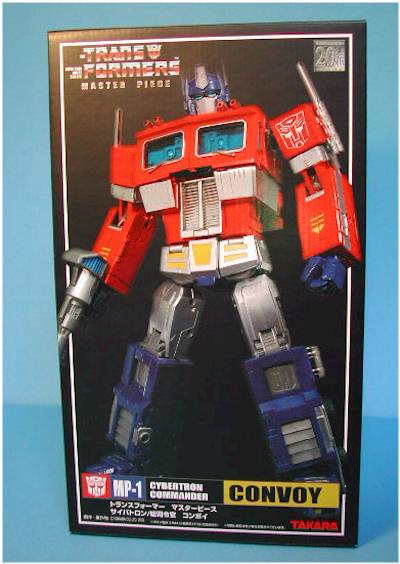
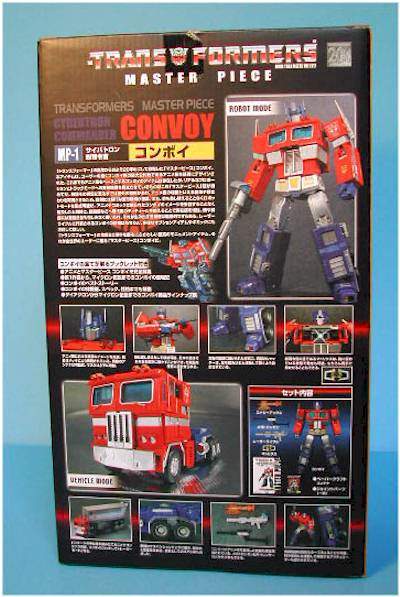
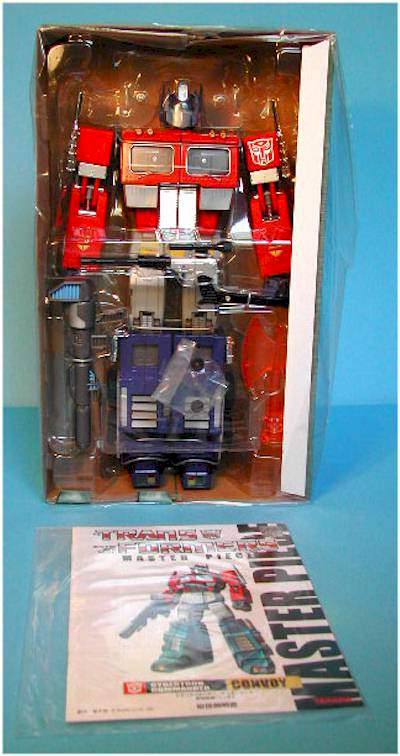
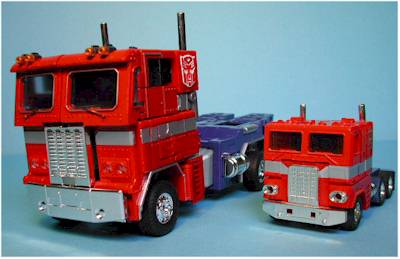
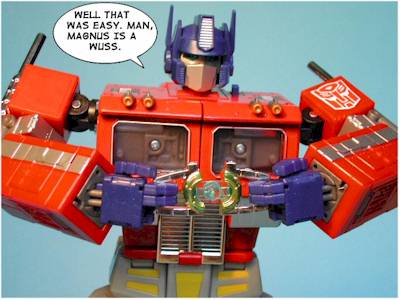
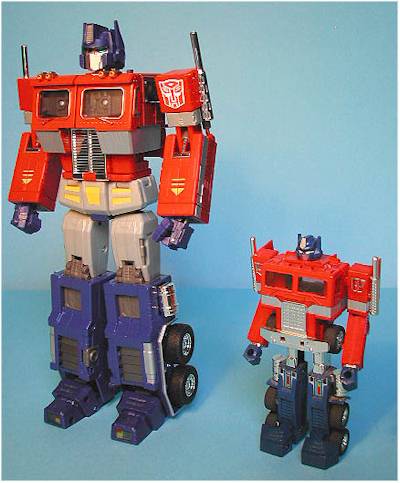
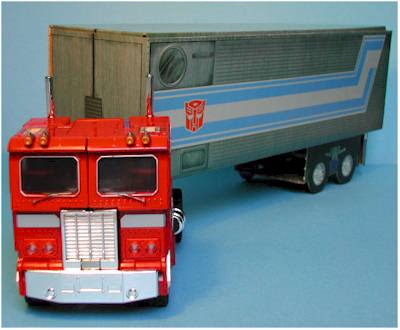
|
However, there has been a change in my thinking in the year since I wrote that piece. I can now see how toys -- at least some of them -- can be viewed as works of "art." Now, I am not going to make an impassioned defense of toys as an art form; that has been done before, never to convincing effect, in my opinion, and to make such an argument would require introducing a lot of aesthetic and cultural studies theory that I don't want to go into. Suffice to say -- and I'll get to the good stuff in a moment, I promise -- that I now believe toys can, at least, be judged by a series of aesthetic standards, similar to the way artistic work are judged. Assuming this is true, then Mr. Crawford's tendency to break his reviews down into component parts involved a prescient understanding of how the products of the current market can be fairly and justifiably judged.
In any event, the upshot of all this is that I will no longer have the long, tangential preambles before getting to the review (present review excepted). I will discuss the toy's history outside its toy incarnation only so much as is necessary to appreciate the efforts of the toymakers (for instance, the way a DC Direct sculpt resembles the work of a particular artist, or the many cartoon-inspired features of Masterpiece Optimus). But enough preamble! There is perhaps no better toy to serve as the test model for my new review paradigm than Masterpiece Convoy, a.k.a. 20th Anniversary Optimus Prime.
Usually Transformers toys are designed by working from the "transformed" form backward to the robot form. This is certainly how the original Optimus Prime was designed lo those twenty years afore. He was a truck first, a robot second. According to
Wikipedia, it was a fellow named Floro Dery who interpreted the robotic forms into the robot designs used for the cartoon and comics. These designs took the robot form as inspiration, but added more "human" elements to the design to make the robot seem more natural.
There have been several Optimus Prime toys over the years that have used the cartoon design rather than the robot form from the original -- most notably the
Medicom "Metal Force" figure. But none of these figures have been able to transform, due to the dissimilarity between the original figure and the cartoon form. To celebrate the twentieth anniversary of the Transformers, Takara chose to create a new Optimus Prime who was as close as possible to the iconic robot form, but could transform into a truck, just like the original.
My misty memory seems to recall that this toy was three years in the making. It shows. While the price tag, at approximately $100, is high, the exchange is perhaps one of the greatest action figures ever made.
Packaging - **
The packaging for the Japanese toy is disappointing: a large black box with a graphic of the figure on the front and some more pictures and information (mostly in Japanese) on the back. The closed box means that there's not much here for MOC collectors -- better to get the window-boxed American version.
Design - ****
Ordinarily I would title this "sculpting," but I think "design" works a bit better here. In terms of looks, this Optimus is astounding. It is a dead-on likeness of the familiar
cartoon form of the Autobot leader. Some have suggested the somewhat "buff" physique was inspired by the work of comic artist Pat Lee, but without direct evidence I'm not sure that's true. If anything, this resembles Optimus as he looked in the 1986 movie. The work is superb. From the single Autobot sign on the left shoulder to the reflective blue eyes, no detail has been overlooked. One of the more subtle but most significant is the way the silver bands along the torso angle slightly inward; the silver is taken from the original design, but the curving -- part of the cartoon design -- gives the impression of a buff "V-shaped" torso.
In the Japanese version of the toy -- the only one I own -- the upper chest and lower legs are made from die-cast metal, making this one heavy figure. But this is also a homage to the original figure. He stands just under 12" tall and is almost the exact same height as the Medicom
Optimus.
The figure also features working pistons in several areas, and the vents on the legs can be opened and closed. The chest opens to reveal a removable Matrix of Leadership.
(Note: as anyone who is familiar with this toy knows, the Japanese version has full-length smokestacks, while the American toy's are shorter -- allegedly for safety reasons. I admit I paid the extra thirty bucks just for those damned longer stacks.)
Paint - ****
The paint applications are not too complex here -- other than the die-cast portions, most of the parts are simply cast in the necessary color. But the colors are pleasingly vibrant and accurate to the cartoon model. The paint does exactly what it needs to, and thus I give it four stars.
So far, the paint hasn't shown any tendency to chip, but then, I'm not exactly playing with this toy in the sandbox.
I should also note here that, rather inexcusably, the American version sports a weathered, battle-damaged paint job. Why? I don't know.
Articulation - ****
This is easily the category where the designers outdid themselves. It wasn't enough, it seems, to get the cartoon robot to transform into the truck. They added an incredible amount of articulation to this figure.
It would be difficult to list it all, but here are a few highlights. The head is ball-jointed (and removable). The shoulders and hips have a range of motion that is very close to that of a ball-joint. Each individual finger is articulated, allowing Optimus to offer what is, in my hometown of Boston, the traditional
driver's sign for "I do not appreciate the way you just cut me off." The thumb has an actual ball-joint, allowing him to hold his weapons while also being able to make a fist. And believe it or not, even the
wrist has a ball-joint-like range of motion. Even the ankles have both vertical and horizontal mobility, allowing Op to stand with legs akimbo.
Check out the pictures for more examples of Op's posability.
Accessories -***
Optimus comes with five accessories: his rifle, the Matrix, his alternate "energy-axe" hand, a Megatron pistol, and two little round black things whose purpose I have yet to divine (if anyone wants to email Mike with the answer, he can add it as a note to the review).
The Matrix, as you can see from the picture, can be removed from Op's chest and "opened," just as in the movie. I like the use of the clear blue plastic for the interior. Again, excellent attention to detail.
The laser rifle is cartoon-accurate in form, but why is it gray instead of black? There is a small bit of clear green plastic in the barrel of the gun, adding a nice laser-like feel.
The Japanese version of the toy also comes with one last accessory. The cardboard tray that contains the toy can be folded into a cut-out trailer (see pic). While this is hardly as good as having an actual trailer (or a
custom one), it's yet another nice touch.
|
|
The addition of the Megatron gun perplexes me. While the design and execution are great -- all the little black parts can be removed, just like the original toy, and the barrel slides into two sections so it can be held in Op's somewhat thin hands -- why does Optimus have a Megatron gun? This strikes me as something the Takara folks may have had lying around and decided to toss in.
The energy-axe arm, seen, if I recall correctly, only in the cartoon episode "More than Meets the Eye, Part 2" is another excellent accessory. It is even sculpted to have energy "waves" along its surface, and it can pivot at the base.
Transformation - ****
One of the great achievements of the designers was to retain the basic traits of the original transformation (bend the legs back, flip back the head, tuck in the shoulders and slide in the arms) while essentially flipping the paradigm: they started with the robot first and figured out how to make it into a truck. As a result, there are a lot of redundant parts. For instance, the figure has two grills -- one for the robot and one for the truck -- and the aforementioned silver stripes along the torso aren't the ones that actually mark the cab.
That said, the transformation is the product of genius. I was particularly impressed with the way the truck's grill was used to make an almost cartoon-accurate cover for the Matrix inside Optimus's chest. The Japanese directions are bit difficult to follow, but as with most Transformers, once you've done it once it's a lot faster the second time around. I wouldn't even call this the most difficult transformation I've had to do.
The truck form, as you can see from the picture, closely resembles the original. To be honest, I'm simply amazed to think that incredible robot form could transform into the truck. It's the first toy transformation (for G1, anyway) to do justice to the nature of transformations seen on the show.
|
|
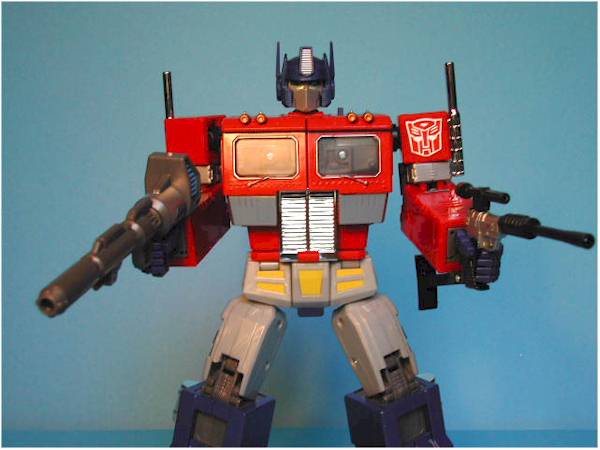
|
|
Play Features/Fun Factor - ***
Optimus comes with a few "hidden" features. With the addition of two small batteries (the little round watch-type, not AAAs), the Matrix can light up with the press of a small button next to Optimus's head. I haven't bothered to buy the batteries yet, so I don't know what this looks like. But it's a neat feature. However, since the light is set in the Matrix's holder, it can only work when the Matrix is implanted in Op's chest.
A slightly more interesting, if bizarre, feature is the button the back of Op's head, which causes his faceplate to move as if speaking. You can even see a little nose and mouth behind the faceplate.
Also, Op has a panel on each arm that can flip up to reveal a picture of Bumblebee on one and Starscream on the other -- just so Op can keep tabs on his least useful soldier and most inept foe.
Both the faceplate and the panels are interesting features that don't hurt the sculpt, but they also strike me as very kid-oriented features. At an SRP of $60-$70, I question how many young kids are going to own this guy. As for the fun factor, while this is a great toy for collectors to pose and display, I question how much it would hold up to daily use by a child.
Value - ***
Masterpiece Optimus isn't just a toy -- this is an event. It's the toyetic equivalent of a blockbuster movie -- a
good blockbuster movie, like JAWS or Ghostbusters. It's hard to put a price on that.
But $100 (or $70 for the American version) is steep, even with everything the figure includes. As such, I just can't give it four stars in this category.
|
|
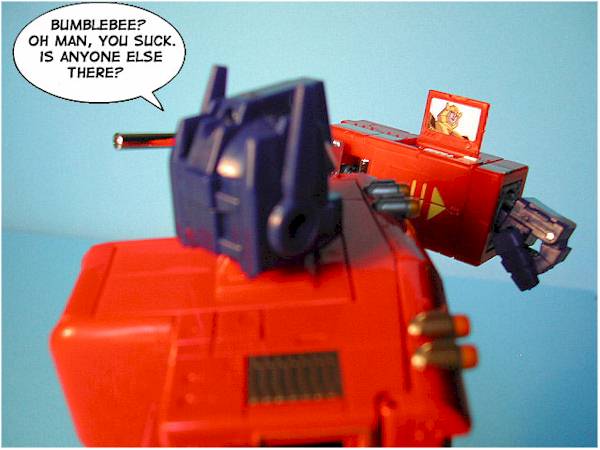
|
Overall - ****
Despite the price, I do think this is one of the best action figures I've ever owned. In terms of my favorite Transformer, I'm afraid Masterpiece Optimus will have to rest behind the G1 Grimlock (my favorite toy ever) -- but
just behind it. With an excellent, inventive design, an ingenious transformation, Masterpiece Optimus Prime is very likely to be my pick for the toy of 2004.
Where to Buy -
I picked up my Japanese Convoy from BigBadToyStore for the fairly reasonable price of $105 (plus only $5 shipping). You can get the American version at your local Wal-Mart or Toys 'R Us for about $75 (or you can nab it online from
Amazon.com).
If you're a diehard collector, I'd recommend spending the extra cash to get the long smokestacks and the clean paint job; otherwise, you know they're just going to gnaw at you every time you look at the figure.
|
|
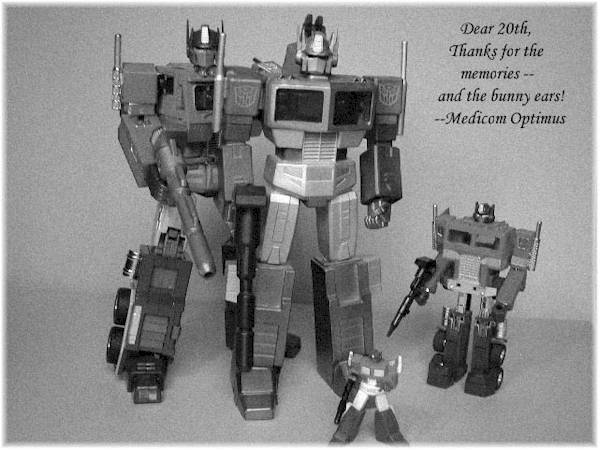
|

Figures from the collection of
Poe Ghostal.
|

